MARIANI’S
Virtual
Gourmet
April 15, 2018
NEWSLETTER
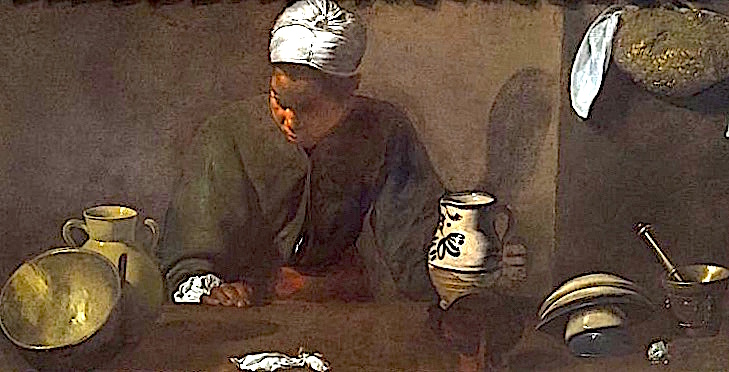
❖❖❖
IN THIS ISSUE
TWO TOP DINNERS
(AND A BIT OF NOSHING) IN TORONTO
By John A. Curtas
NEW YORK CORNER
HARRY'S
By John Mariani
NOTES FROM THE WINE CELLAR
Spain’s Abadia Retuerta Wins Renown
Without a Regional Appellation
By John Mariani
❖❖❖
TWO TOP DINNERS
(AND A BIT OF NOSHING)
IN TORONTO
Text and photos by John A. Curtas
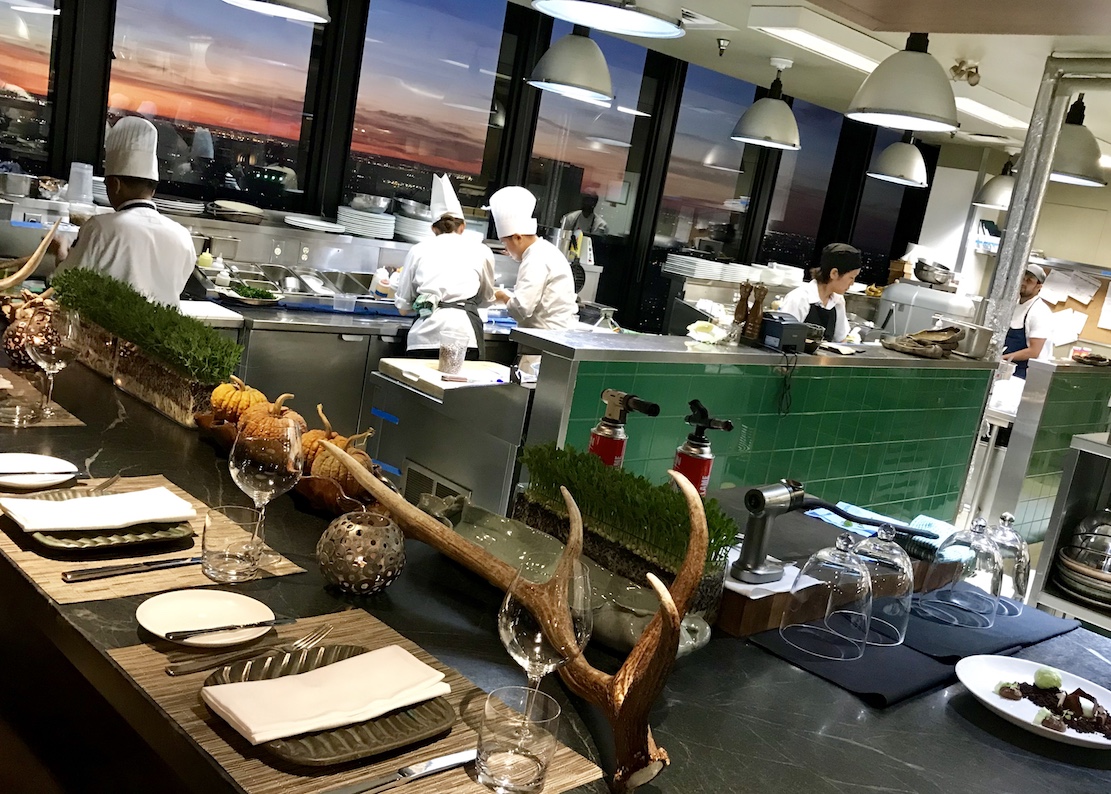
CANOE
The
trouble with a great food city is that
temptation is always around every corner. Two
dinners aren’t nearly enough to
satisfy anyone’s hunger or curiosity about all
the good things to eat in
Toronto, but with a little research, and the
help of Chris Nuttall Smith, the
former restaurant critic for The Globe and Mail,
I recently squeezed as much
noshing into 48 hours as I could—including two
stunning meals on opposite ends
of the restaurant spectrum.
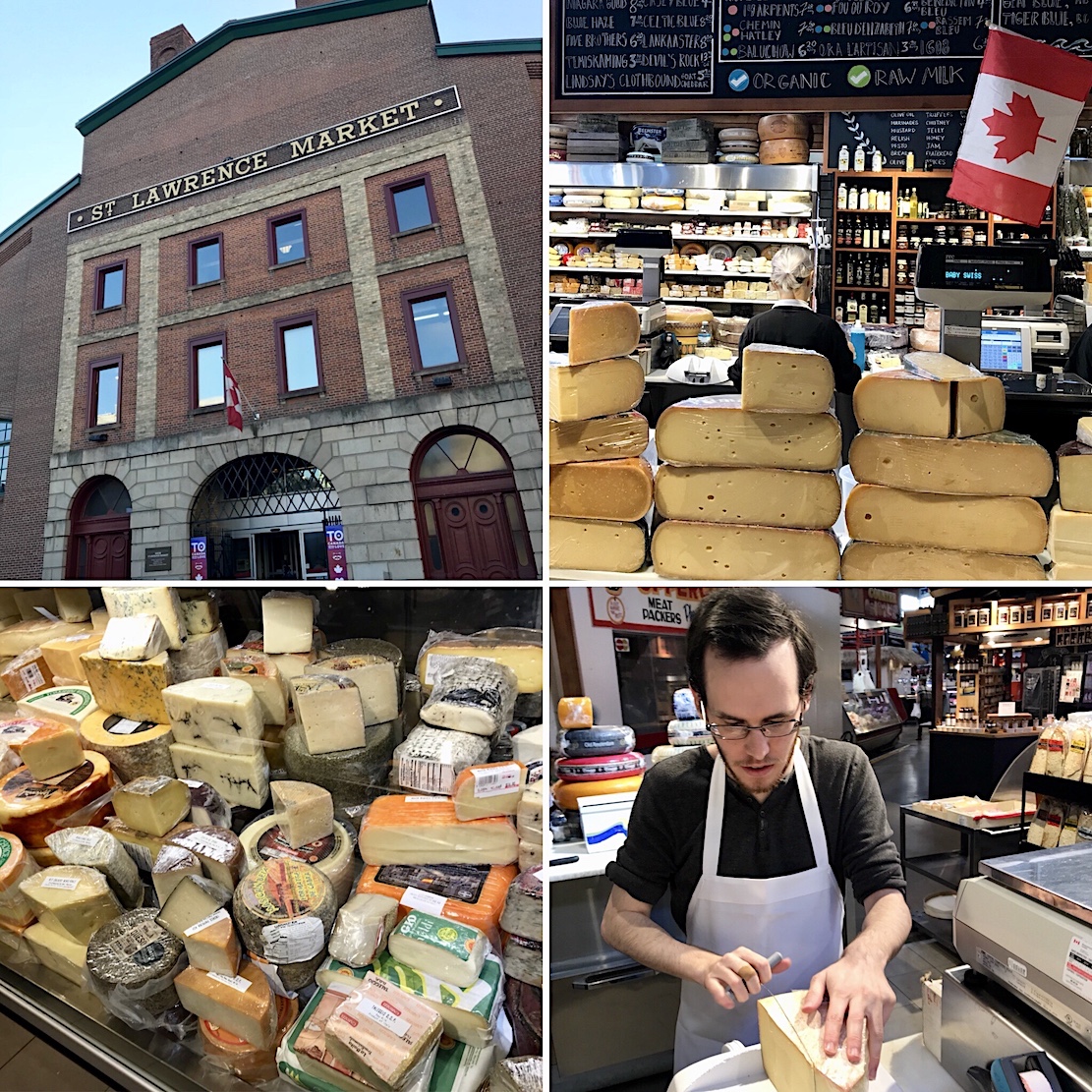 Before my
wife and I got to those restaurants
though, two obligatory stops were in order: first,
at the world famous St.
Lawrence Market, home of Canadian artisan
cheese purveyor Olympic
Cheese Mart (left).
Even for an old caseophile like me, the selections
at Olympic can be
overwhelming. It displays hundreds of wheels from
every cheese-producing
country in the world, but the things to sample are
the artisanal Canadian
cheddars. A giant board lists these in-house-aged
beauties, some of which have
been two decades in the making—and you will want
to sample every one. (Try
to go early, before the lunch rush, and you’ll
find the cheese mongers very
generous and informative.) There is even a
"guilt-free cheese"
section for those who recoil at the thought of
lactose-laden, animal
rennet-coagulated real cheese. Be forewarned,
however, that having those
aversions and coming here is like swearing off sex
and strolling through a
bordello.
Before my
wife and I got to those restaurants
though, two obligatory stops were in order: first,
at the world famous St.
Lawrence Market, home of Canadian artisan
cheese purveyor Olympic
Cheese Mart (left).
Even for an old caseophile like me, the selections
at Olympic can be
overwhelming. It displays hundreds of wheels from
every cheese-producing
country in the world, but the things to sample are
the artisanal Canadian
cheddars. A giant board lists these in-house-aged
beauties, some of which have
been two decades in the making—and you will want
to sample every one. (Try
to go early, before the lunch rush, and you’ll
find the cheese mongers very
generous and informative.) There is even a
"guilt-free cheese"
section for those who recoil at the thought of
lactose-laden, animal
rennet-coagulated real cheese. Be forewarned,
however, that having those
aversions and coming here is like swearing off sex
and strolling through a
bordello.
Our
second stop was at the more bohemian Kensington Market,
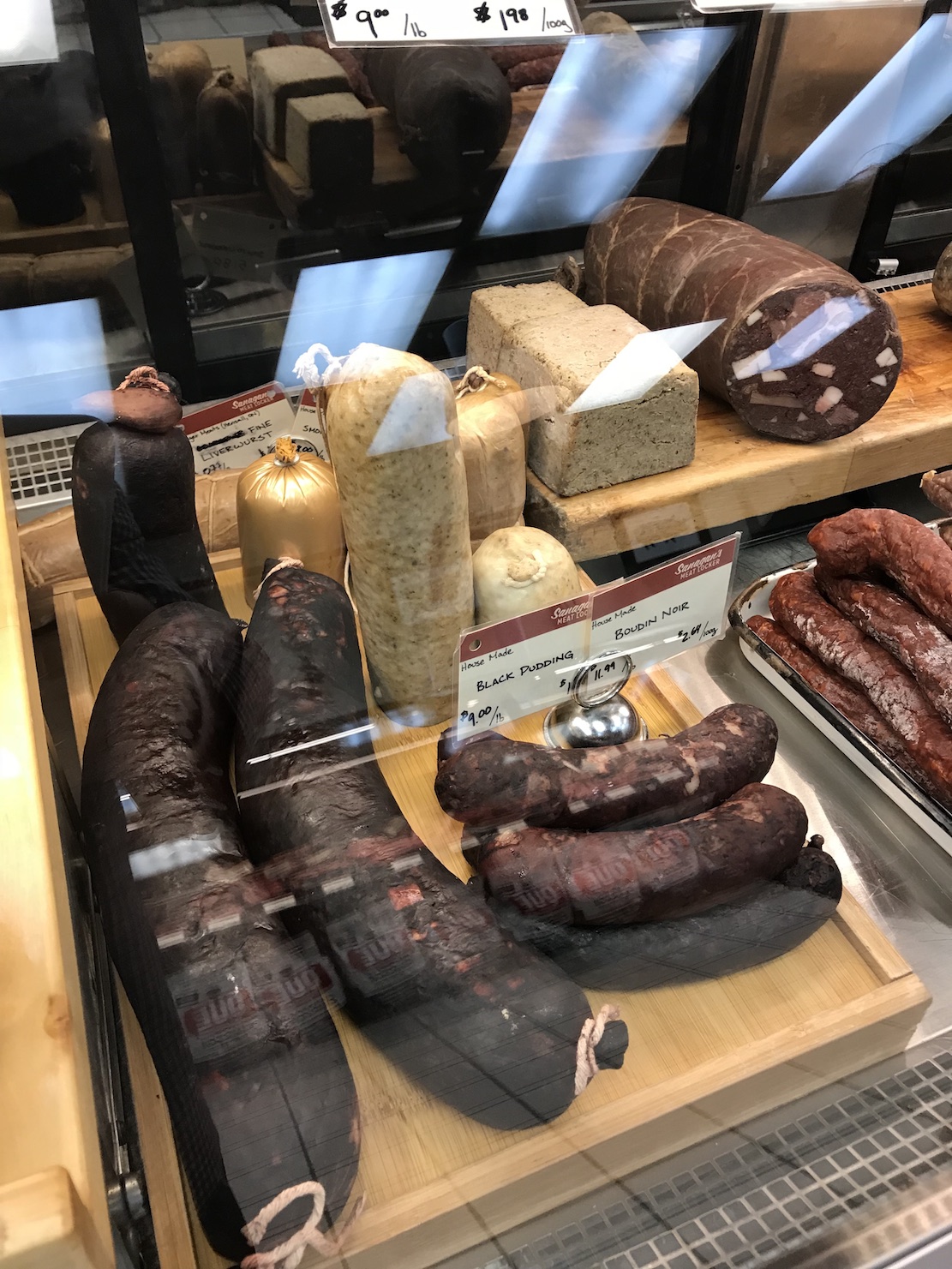 where, interspersed
among the raggedy storefronts and vintage clothing
shops, are two foodie meccas
next door to each other: the Blackbird Baking Co.
and Sanagan's
Meat Locker (right),
both founded within the past five years by local
chefs looking for a career
change. Simon Blackwell worked in the iconic River
Café in London before becoming inspired by the
work being done at Amy's Bread and the Sullivan
Street
Bakery in New York, while Peter Sanagan took an
old butcher shop and turned it
into a showcase for the exceptional meat and
poultry being grown by small
Ontario farmers. We were trying to save our
appetites for dinner, but our
willpower faded as soon as we confronted the
European-inspired charcuterie, pâtês
and terrines of Sanagan’s, and the aromas wafting
from Blackbird.
where, interspersed
among the raggedy storefronts and vintage clothing
shops, are two foodie meccas
next door to each other: the Blackbird Baking Co.
and Sanagan's
Meat Locker (right),
both founded within the past five years by local
chefs looking for a career
change. Simon Blackwell worked in the iconic River
Café in London before becoming inspired by the
work being done at Amy's Bread and the Sullivan
Street
Bakery in New York, while Peter Sanagan took an
old butcher shop and turned it
into a showcase for the exceptional meat and
poultry being grown by small
Ontario farmers. We were trying to save our
appetites for dinner, but our
willpower faded as soon as we confronted the
European-inspired charcuterie, pâtês
and terrines of Sanagan’s, and the aromas wafting
from Blackbird.
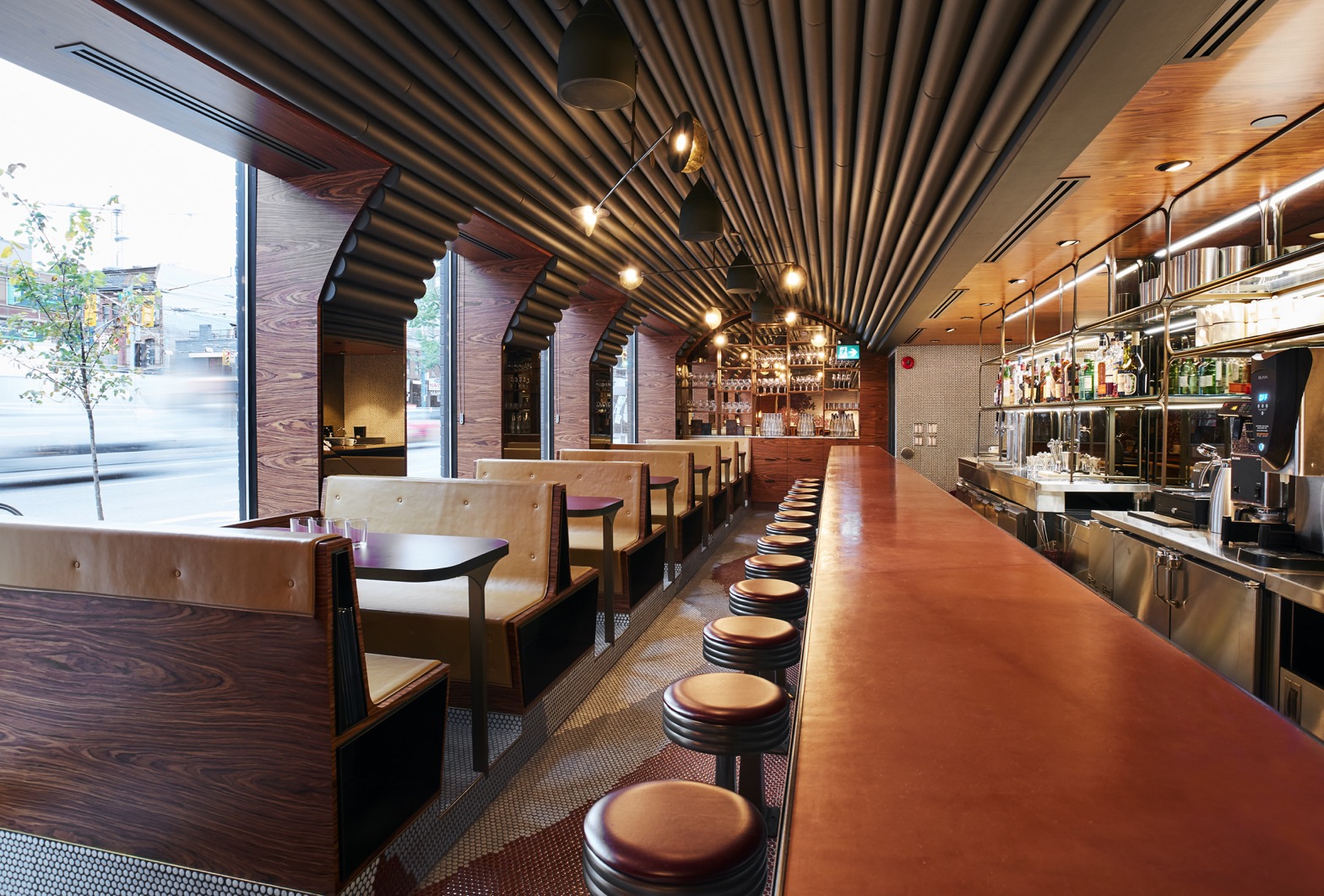 Resistance
was equally futile when we stumbled
upon Aloette
(left; 163 Spadina
Ave.), just
a few blocks from
Kensington Market. which Smith had urged us to
check out, and
at that point it would've been rude not to.
Besides, by then it had been at
least thirty minutes since we had munched on
the succulence of Sanagan's
lemon and mustard headcheese and the tangy crust
of Blackwell’s sourdough.
Resistance
was equally futile when we stumbled
upon Aloette
(left; 163 Spadina
Ave.), just
a few blocks from
Kensington Market. which Smith had urged us to
check out, and
at that point it would've been rude not to.
Besides, by then it had been at
least thirty minutes since we had munched on
the succulence of Sanagan's
lemon and mustard headcheese and the tangy crust
of Blackwell’s sourdough.
Billed as an upscale diner
serving "comfort food with a twist,"
Aloette is long narrow room that seats only 38,
but it oozes serious foodie
cred from the bow-tied bartenders to the bustling
staff eager to give you the provenance and
technique behind every dish. As we
were only there for an aperitif, the delights of
the menu were mostly seen
rather than tasted, but there was no faulting the
warm brioche bread with brown
yeast butter, or the briny, sparkling oysters—both
raw and grilled—that paired
perfectly with a crisp Pearl Morissette Chardonnay
from the
Niagara-on-the-Lakes wine region.
By
then it was time for dinner. Given our carb and
charcuterie consumption, we
probably should have walked up the 54 floors to  Canoe, (66
Wellington Street W) but instead we elevated
to this spectacular room in the TD Bank Tower and
were lucky to catch a
dramatic sunset over Lake Ontario. What showed up
on the plate was every bit
the equal of the scenery. Canoe is now over twenty
years old, but the room,
service, and cuisine feel as fresh as they did
when I last visited in 2001.
Executive Chef John Horne uses the entire palette
of Canadian flavors to craft
a cuisine that is classically rooted but very much
of its place. Seasonal and
local are the watchwords that guide this cooking,
and even if those terms are
overused these days, they seem right at home when
the bounty of Ontario is
laid before you. Everything from the vibrant
green bean salad with wild
ginger, pickled onion and sweet pea hazelnut
vinaigrette to locally foraged
roasted mushrooms had that hand-picked brightness
that shines through when the
vegetables come from no farther away than the next
county.
Canoe, (66
Wellington Street W) but instead we elevated
to this spectacular room in the TD Bank Tower and
were lucky to catch a
dramatic sunset over Lake Ontario. What showed up
on the plate was every bit
the equal of the scenery. Canoe is now over twenty
years old, but the room,
service, and cuisine feel as fresh as they did
when I last visited in 2001.
Executive Chef John Horne uses the entire palette
of Canadian flavors to craft
a cuisine that is classically rooted but very much
of its place. Seasonal and
local are the watchwords that guide this cooking,
and even if those terms are
overused these days, they seem right at home when
the bounty of Ontario is
laid before you. Everything from the vibrant
green bean salad with wild
ginger, pickled onion and sweet pea hazelnut
vinaigrette to locally foraged
roasted mushrooms had that hand-picked brightness
that shines through when the
vegetables come from no farther away than the next
county.
Horne's take on s'mores was also a r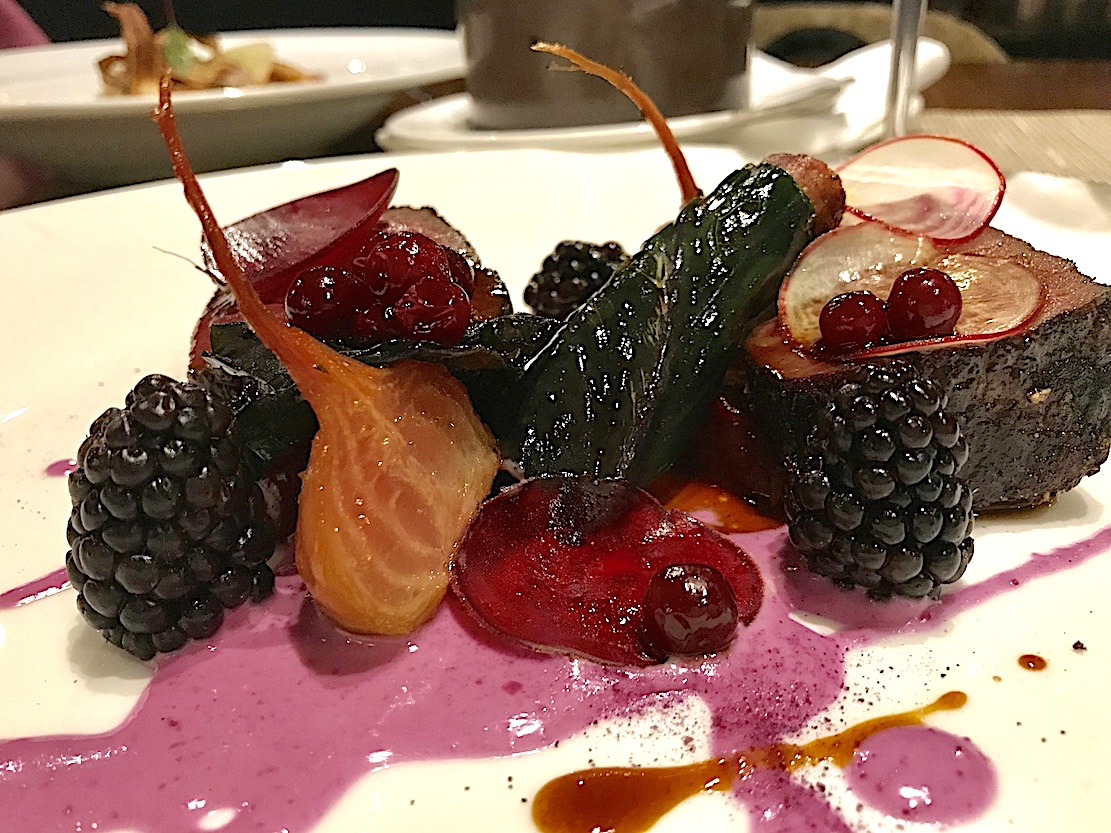 elevation, as he parked
a
generous slab of Canadian duck liver (right) on a
Graham cracker "crumble"
(more of a small square cake) beside which sat a
generous dollop of toasted
marshmallow cream. Some swirls of chocolate sauce
completed this grown-up,
lip-smacking deconstruction of the campfire
classic.
elevation, as he parked
a
generous slab of Canadian duck liver (right) on a
Graham cracker "crumble"
(more of a small square cake) beside which sat a
generous dollop of toasted
marshmallow cream. Some swirls of chocolate sauce
completed this grown-up,
lip-smacking deconstruction of the campfire
classic.
The main courses—Great
Lakes pickerel with smoked oyster mayonnaise, and
Québec red stag with foie
gras sausage, beetroot and berries (left) were
also so on point it was a bit
astonishing, as were the premium Canadian cheeses
that finished our meal.
Cooking this high up is not supposed to be this
focused,
this much fun, or this good. Calvin Trillin once
famously remarked that the
higher you get off the ground the worse the food
gets, but the cuisine of Canoe
is all that and more. 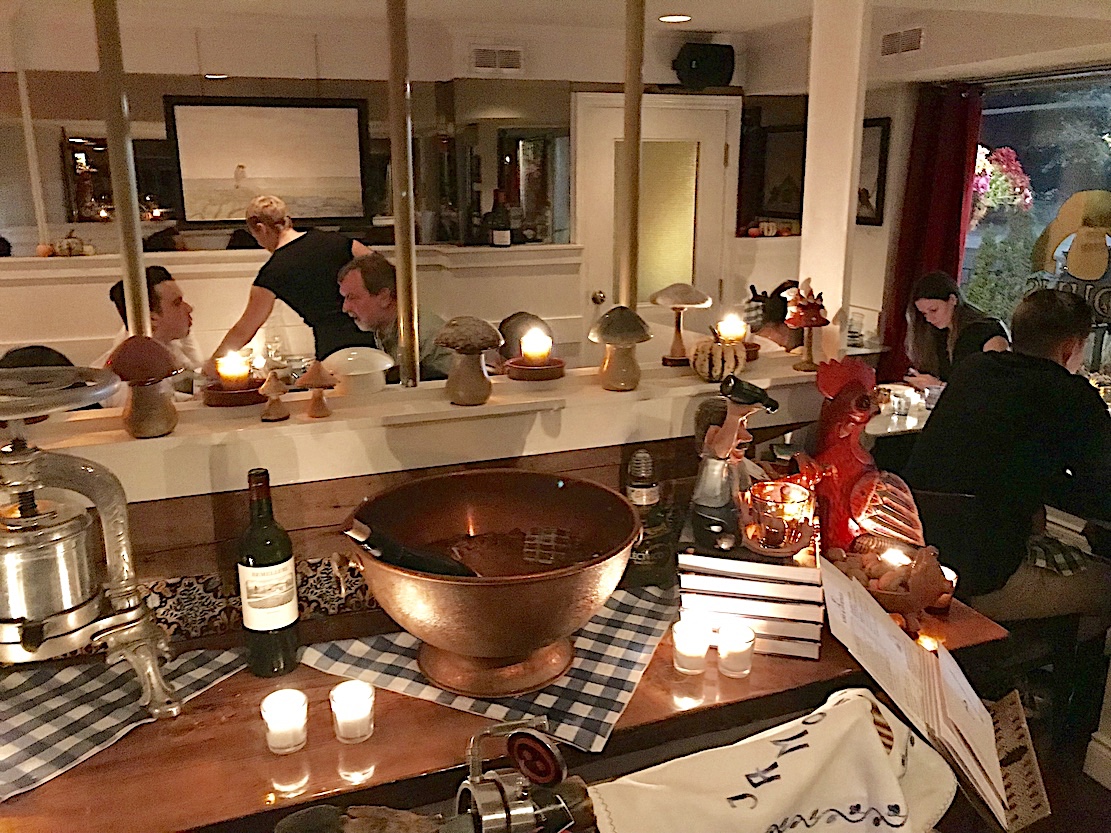
From the
tallest meal in town to a humble
cottage, our second dinner in Toronto couldn't
have provided a nicer contrast.
Where Canoe is a philharmonic of panoramic sights,
giant open kitchen and
a thriving cocktail bar, Edulis (right; 169 Niagara
St.) is
more like a pitch-perfect string quartet
playing in a minor key. The impression upon
approaching Edulis (another name
for the cepe mushroom) is one of a prettified
small inn where the family cooks
everything from the farm and cossets you from the moment you enter. It may
look casual but the food is
super-serious, and the feeling you get is of
peaceful expectation—a gentle
knowledge that you're in the hands of chefs in
full control of their vision of
the perfect restaurant.
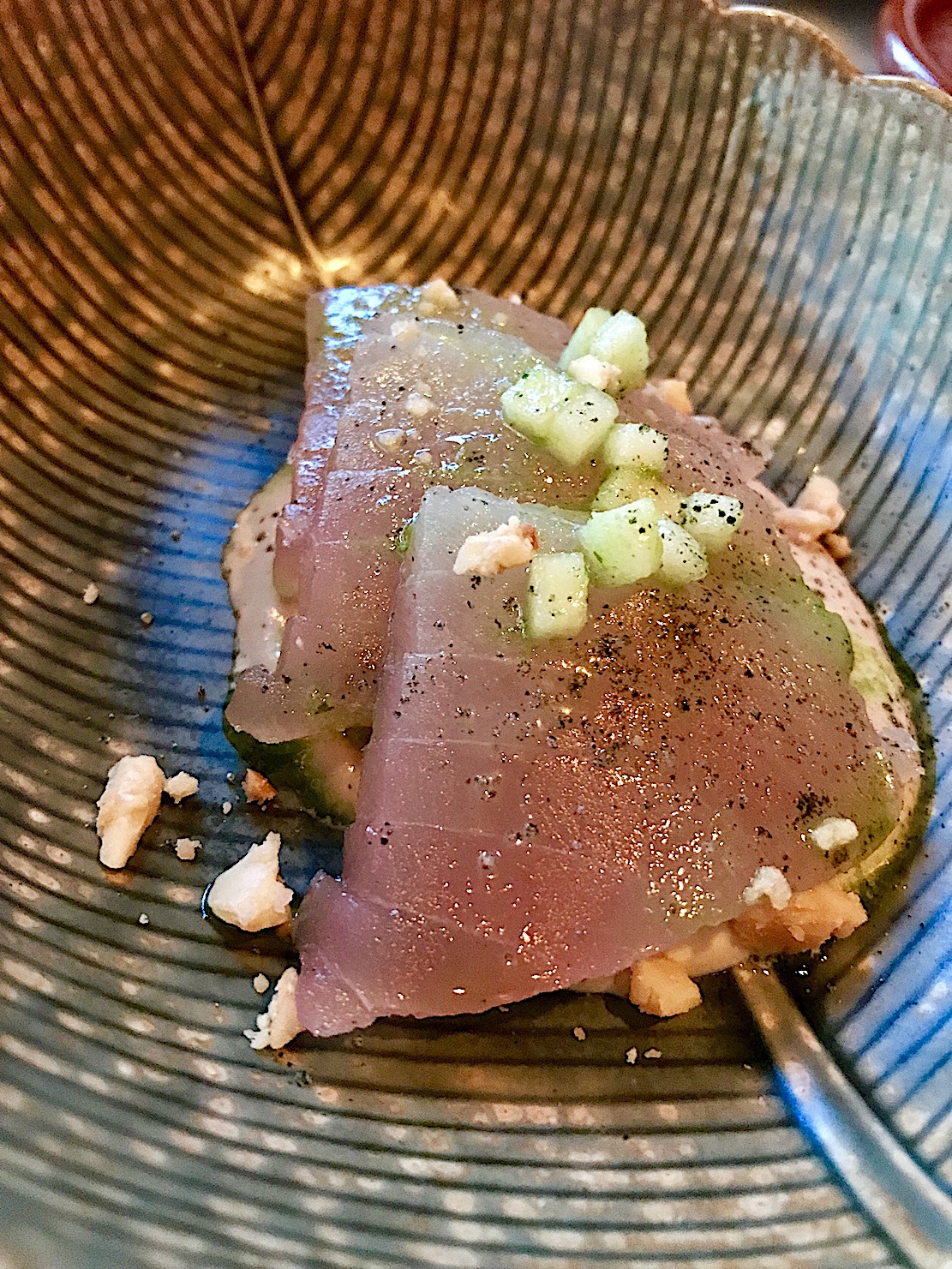 Those chefs—the
husband-wife team of Michael
Caballo and Tobey Nemeth—created Edulis as an
homage to the French-Spanish
food that they love. It is small (32 seats) and
very personal (when Caballo and
Nemeth can't be in the kitchen, they close).
Nuttall Smith told me I'd be blown
away by the food, and I was.
Those chefs—the
husband-wife team of Michael
Caballo and Tobey Nemeth—created Edulis as an
homage to the French-Spanish
food that they love. It is small (32 seats) and
very personal (when Caballo and
Nemeth can't be in the kitchen, they close).
Nuttall Smith told me I'd be blown
away by the food, and I was.
Fresh-off-the-boat
Nova Scotia Albacore tuna (left),
hinting at the lightest of cures, began our meal,
followed by chunks of sweet
lobster adorned with tomatillo bits and
wood-roasted poblano peppers.
Sanma (Pacific Saury fish) grilled over binchotan
charcoal showed a light hand
with both the grilling and the use of fresh green
chili, and seaweed-smoked
coho salmon in sorrel sauce (a sly
Troisgros-meets-Toronto reference) was further
evidence of why you should never order salmon
below the 49th parallel, this
specimen being breathtaking in its mahogany
hue and fork-dropping in its
intensity. Ling Cod with cherrystone clams
was followed by tender young
goat cooked with wild grapes and served with
Brussels sprout leaves and
chanterelles. 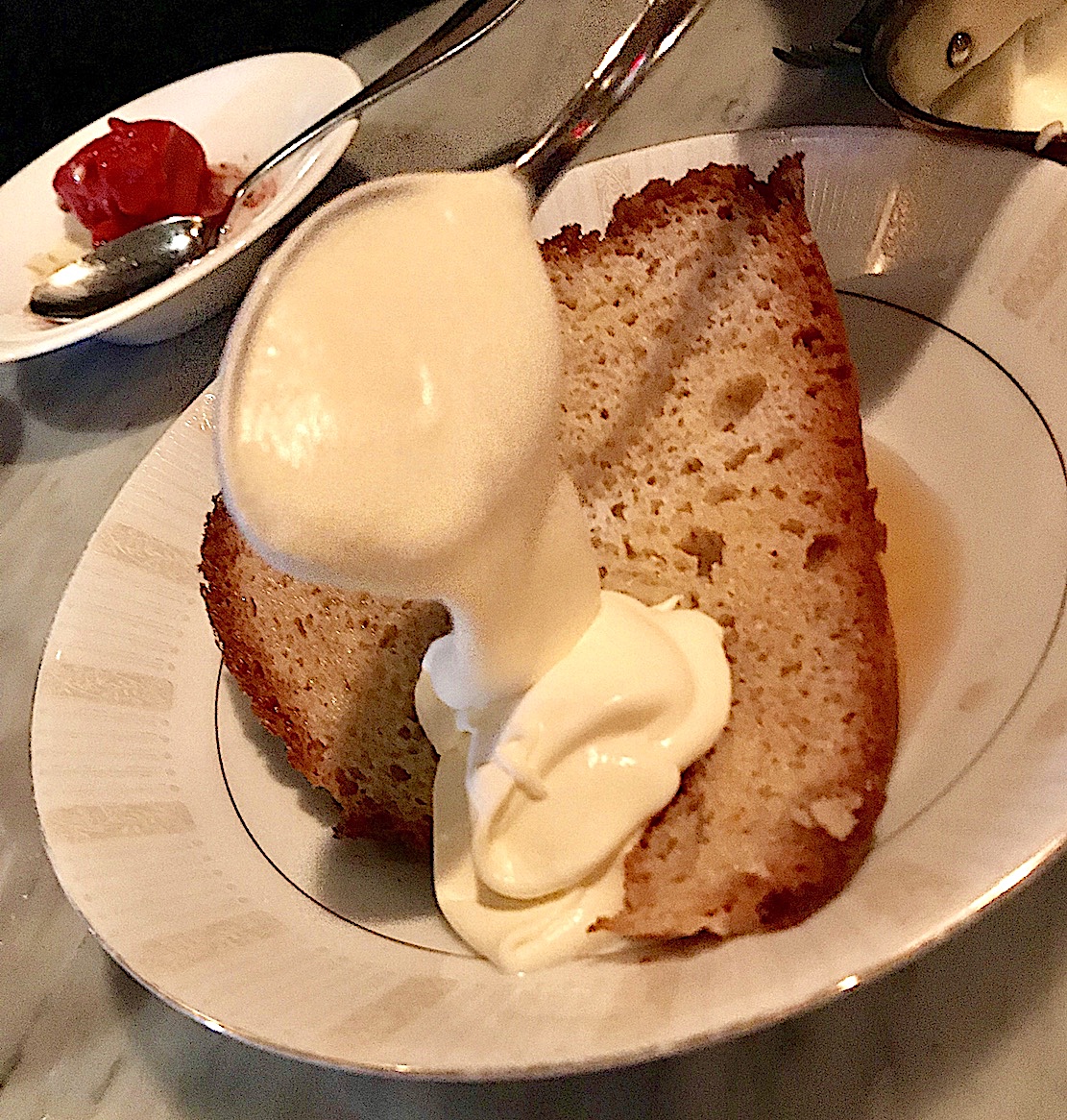
Everything came with a
different sauce—a real
sauce, properly proportioned beneath the star
ingredient, not bare schmears or
ribbons from a squeeze bottle—each a marvel unto
itself, with no repetition of
spice, liquid or accent. "Absolutely stunning,"
was all I could think
through the progression of dishes. Three Canadian
cheeses at the peak of
ripeness ended the savory courses; raspberry
sorbet with buffalo yogurt was the
ideal intermezzo and the finale was a
simple-yet-exquisite baba au rhum with
Chantilly cream (right).
The food was
simple but not too much so, and the progression of
dishes so seamless and
balanced that we regretted ordering the shorter
tasting menu ($90).
The wine list is as eclectic as the food,
with
interesting, well priced bottles from all over
Europe and Canada.
Edulis is one
of those rare finds: a place where you can feel
the passion being served on the plate. These young
chefs are at the top of
their game, and their game is nothing less than an
almost preternatural sense
of how to blend the best European technique to
their own refined, delightfully
Canadian idea of what a restaurant should be.
There are very few restaurants in
the world I can imagine jumping on a plane for,
just to see what the chef is
cooking up, but Edulis is now one of them.
By John Mariani
1 Hanover Square (off Pearl Street)
212-785-9200
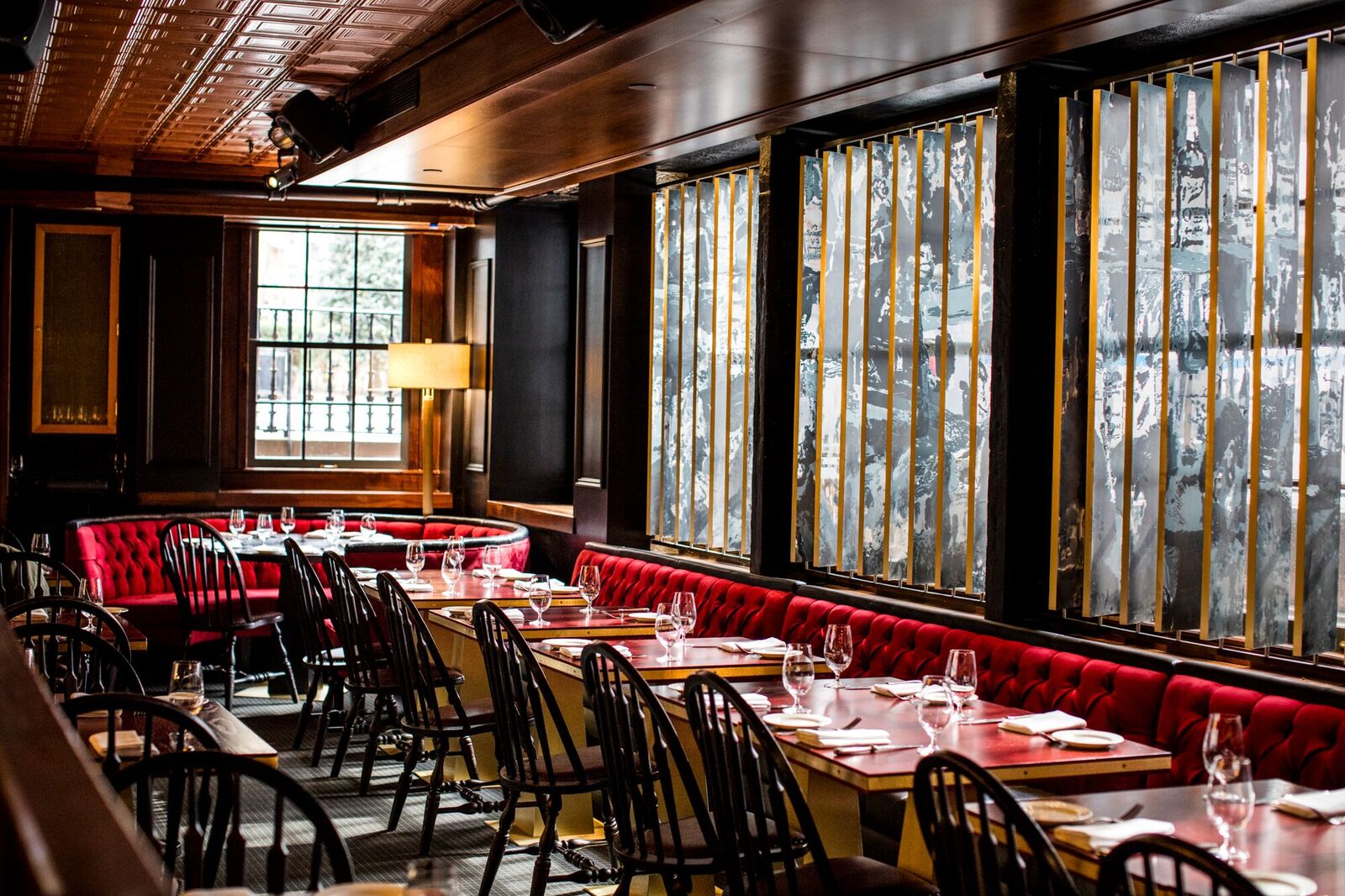
There’s nothing I like more
than a good restaurant with a history, and I’ve
lived long enough to dine at
many of them, especially in New York, home to
places that date back to the 19th
century, like the Bridge Café, Delmonico’s,
McSorley’s Old Ale House and Pete’s
Tavern.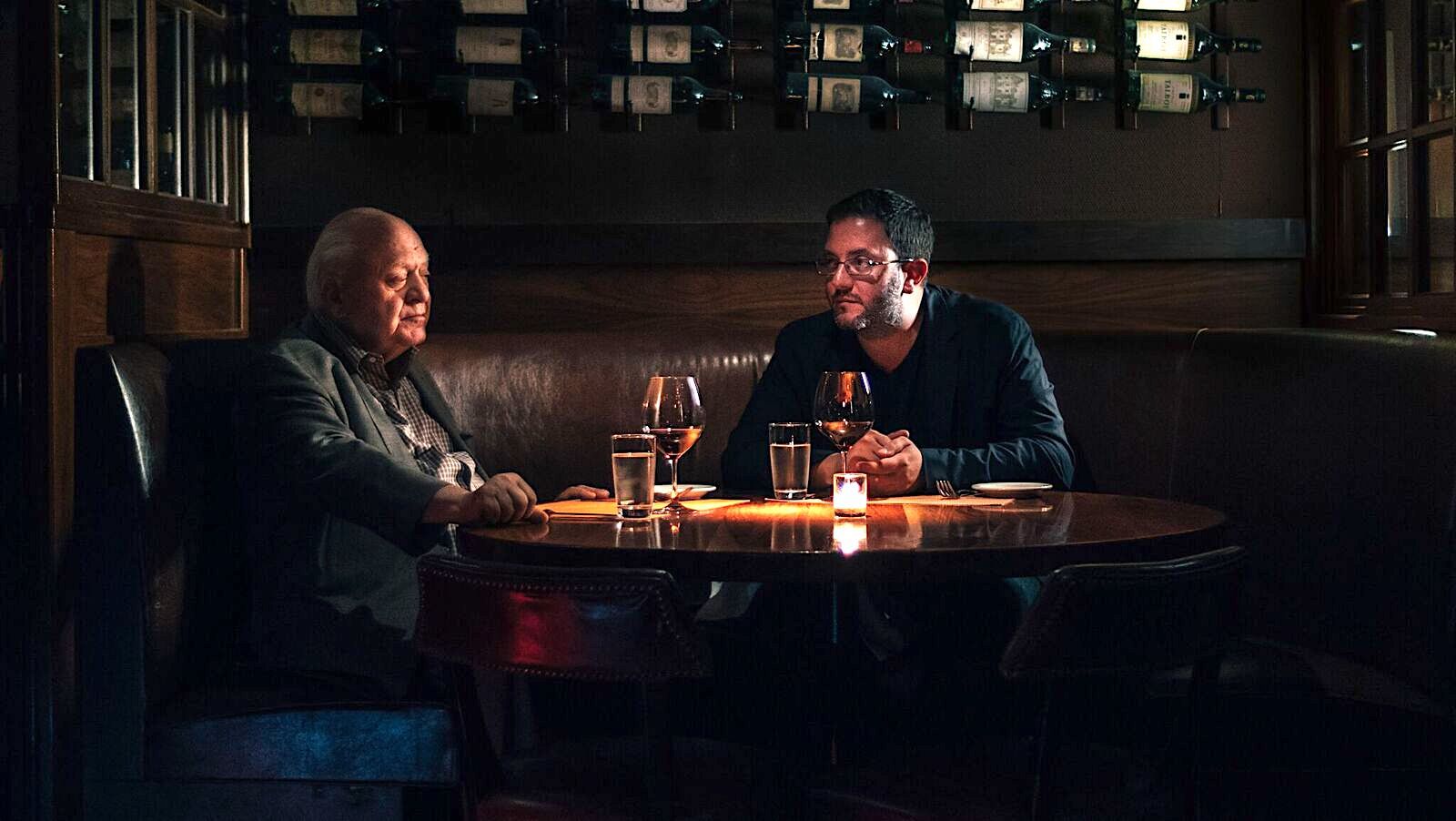
Harry’s has only been
Harry’s since 1972, when Greek immigrant Harry
Poulakakis (right,
with son Peter) turned the premises
of what had been an eating house as early as 1875
into a 20th century financial
district institution, and you can still see the
lineaments of that history in
the woodwork of this below-street-level room.
Through several boom and
bust cycles Harry’s was always there when Wall
Streeters were ready to exult or
when they needed to drown their sorrows; in the
boom times when the brokers and
bankers were flush and ordered $500 Burgundies on
their expense accounts, and
also when they were down on their luck, when
they’d order wine by the
glass. Harry’s
has figured in
novels like Tom Wolfe’s Bonfire of
the Vanities, Brett Easton Ellis’s American
Psycho and Colm McCann’s Let
the Great World Spin.

Harry’s son
Peter has
recently altered the look of the rooms, now
seating 240 guests, including a
handsome bar (left),
with very roomy suede booths with alligator trim
and polished
tables. There are photos of celebs who have dined
there and an odd, glowing
light fixture that made me think the Mother Ship
had landed in the middle of
the dining room, which is otherwise softly
lighted. Loud music no one actually
listens to intrudes out of the
background.
Executive Chef Joe Mallol’s
menu has a cast that a Wall Street restaurant
might well have had a century
ago, a sumptuous screed of seafood and meats from
American waters and farms of
the highest reputation. The lobster bisque ($13)
is
not thickened with flour but instead has the
consistency of a velouté enriched
with seafood and a touch of tarragon.
The French onion soup ($12) came piping
hot, its golden crown of Gruyère
seared, and beneath it a rich broth of caramelized
onions. A seafood tower is
massed with lobster, clams, oysters, shrimp and
crab 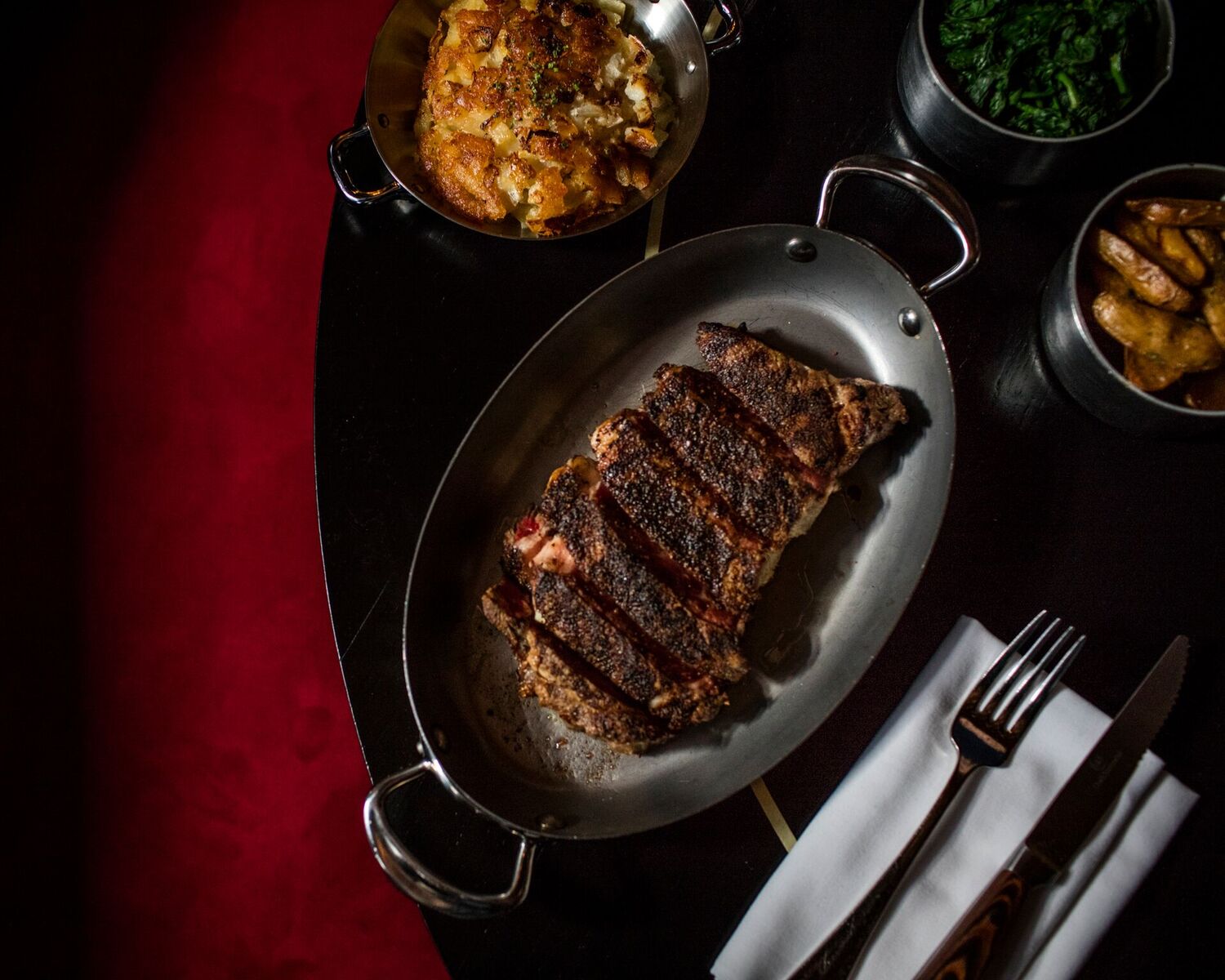 with
several dipping
sauces to choose from. Using Jonah
crab does not make Harry’s crabcake among the best
in the city, though Peter
says they may soon switch to lump crabmeat.
with
several dipping
sauces to choose from. Using Jonah
crab does not make Harry’s crabcake among the best
in the city, though Peter
says they may soon switch to lump crabmeat.
The beef is, as you’d
expect, USDA Prime, dry aged for 28 days and
served sizzling in a hot pan,
perfectly cooked, impeccably seared, with the deep
flavor of fine beef. Harry’s serves some of the
best and
most generously proportioned rack of lamb ($115
for two) around town, of a kind
that makes you wonder why more Americans don’t
appreciate our native lamb.
Roast chicken with green beans amandine ($27) is a
very reasonable, very juicy
alternative to the beef and lamb. The strozzapreti
pasta with short rib Bolognese ($24) would make
some of the
better Italian trattoria chefs in
New York jealous.
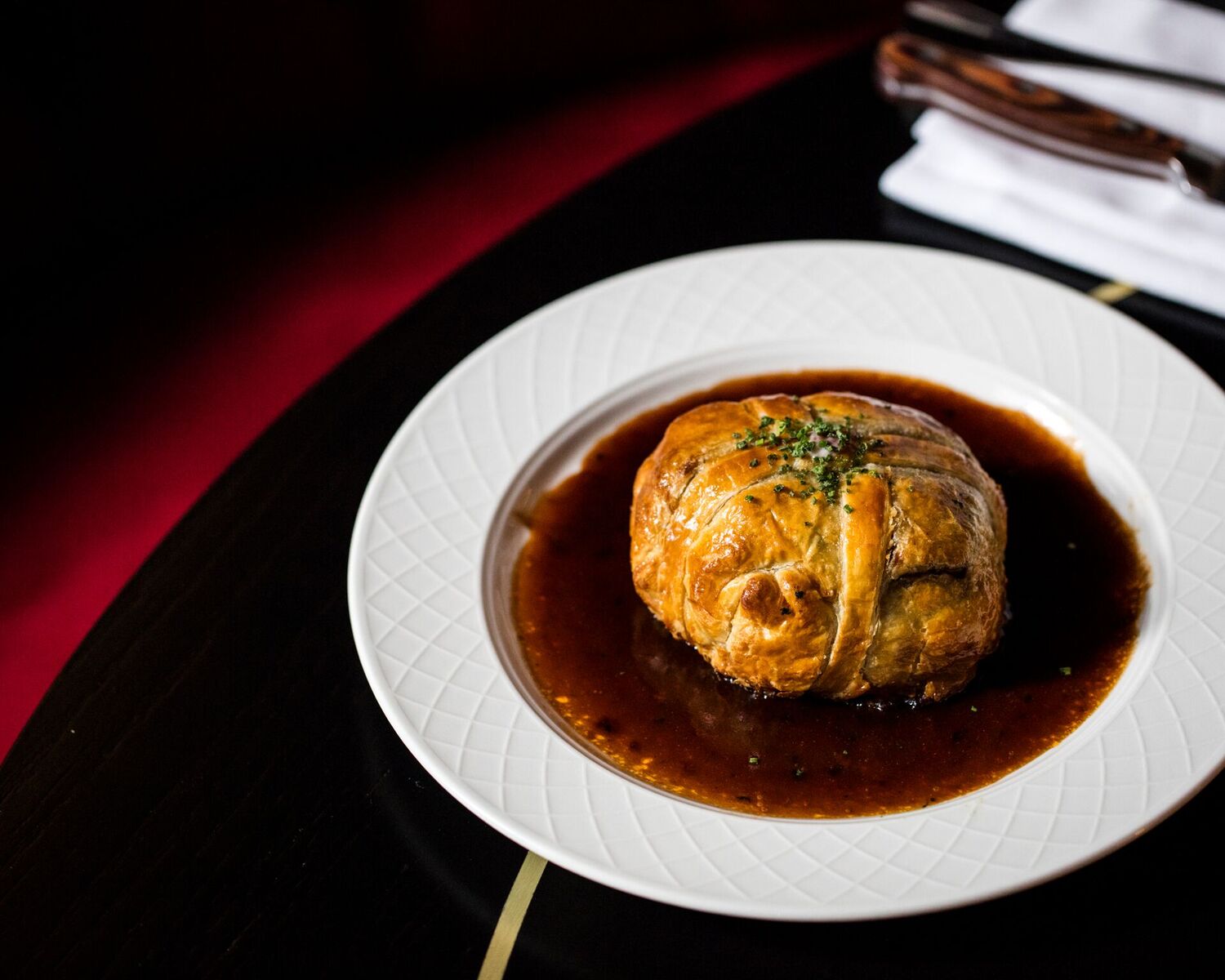
Apparently
for a very long
time now, beef Wellington ($48) has been one of
Harry’s top-selling items (left),
though it is one I usually shy away from because
the pastry crust is never as
crisp as it should be and the interior beef gets
steamy. But Peter urged me to
try it and I’m glad I did. It will never be among
my favorite dishes, but this
was a well-crafted version and I trust it will
stay on the menu for ages.
Just as much attention is
paid to side dishes like hash browns ($12), French
fries ($10), a confit of
fingerling potatoes ($11) and fat tempura-fried
onion rings ($11) with just the
right ratio of batter to sweet onion.
Harry’s
desserts
($10-$15) are legendary for their taste and
largess, from a warm Dutch apple
crumble to a lemon meringue pie, but the signature
item, 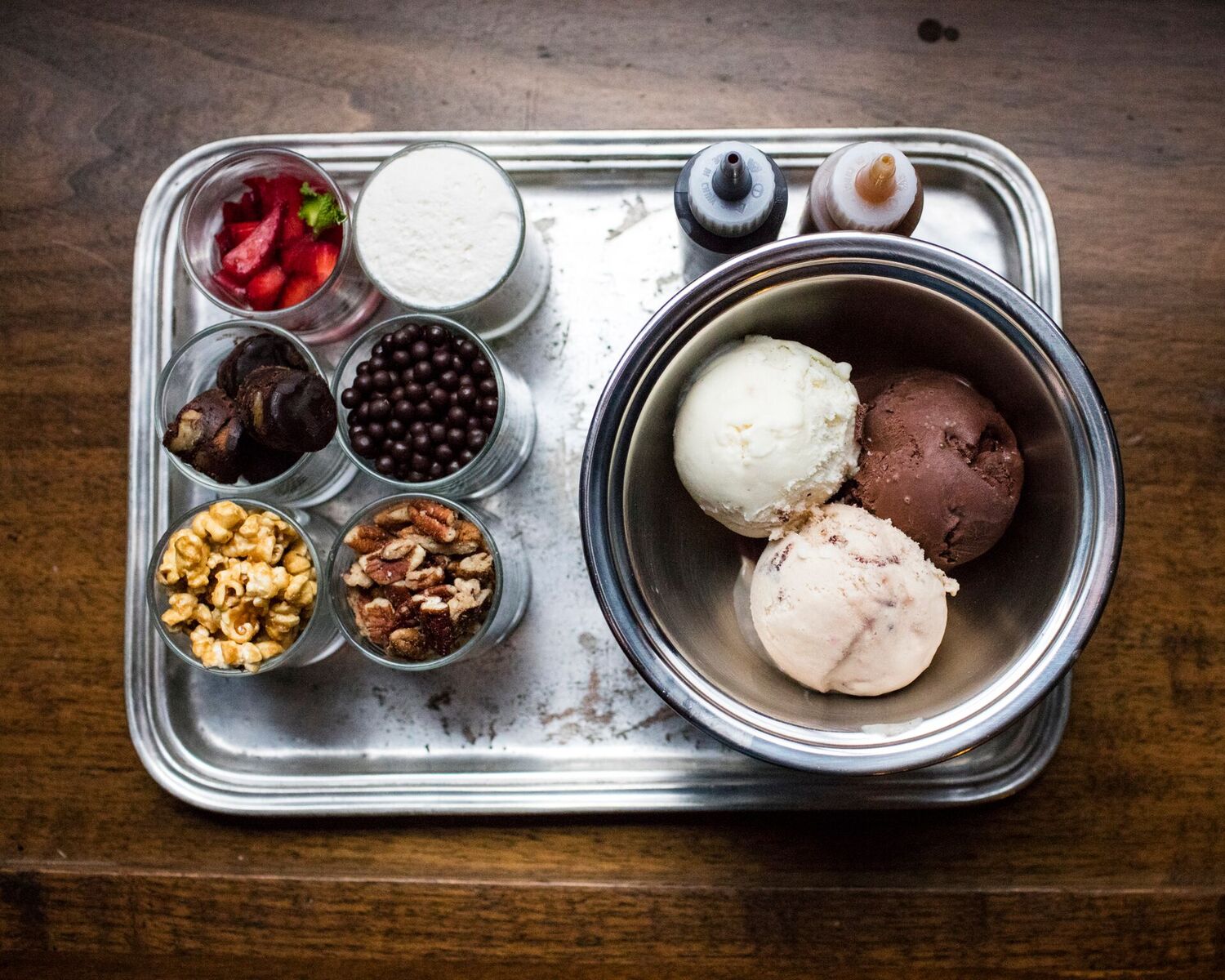 for good
reason, is a
monumental presentation of Harry’s ice cream
sundae, which comes with enough
additions of crisp, crunchy, salty, sweet,
luscious bites and pieces—not to
mention a jigger of Abelour Scotch—to supply a
vintage pharmacy soda fountain
for an afternoon.
for good
reason, is a
monumental presentation of Harry’s ice cream
sundae, which comes with enough
additions of crisp, crunchy, salty, sweet,
luscious bites and pieces—not to
mention a jigger of Abelour Scotch—to supply a
vintage pharmacy soda fountain
for an afternoon.
I could spend paragraphs
going on about Harry’s wine list, built up since
1972 with what were once new
vintages that have now become historic ones, with
plenty of trophy wines left
among the good values from around the globe. The
bar collects its own rare
bottlings, and guests are invited to purchase and
store them at the restaurant
in their own personal chamber.
Harry’s remains where it is
and attracts the clientele it does because it
caters to people who like to eat
and drink with gusto and depend on Harry to
deliver everything with the same
quality and bonhomie as ever. Not
even the horrors of 9/11 were able to snuff
Harry’s out. Dusted off, cleared
out, refinished and opened for business as soon as
possible, it is still as
much a beacon of New York endurance as any
institution in the area. And it’s
not moving anywhere else.
Harry’s is open for
lunch
and dinner Mon.-Sat.
❖❖❖
Spain’s
Abadia
Retuerta Wins Renown
Without a Regional Appellation
By
John Mariani

The Iberian Peninsula
has produced wine since
prehistoric times and its Port and Sherry were
long valued in the British trade
market, after centuries of being made in bulk.
But it was not until the 1970s
that Spanish table wines took on much interest
outside of sangria, and only
after Spain’s entrance into the European Union
in 1986 were the country’s wine
regions classified into 17 autonomous
appellations by the Instituto Nacional de
Denominaciones de Origin.
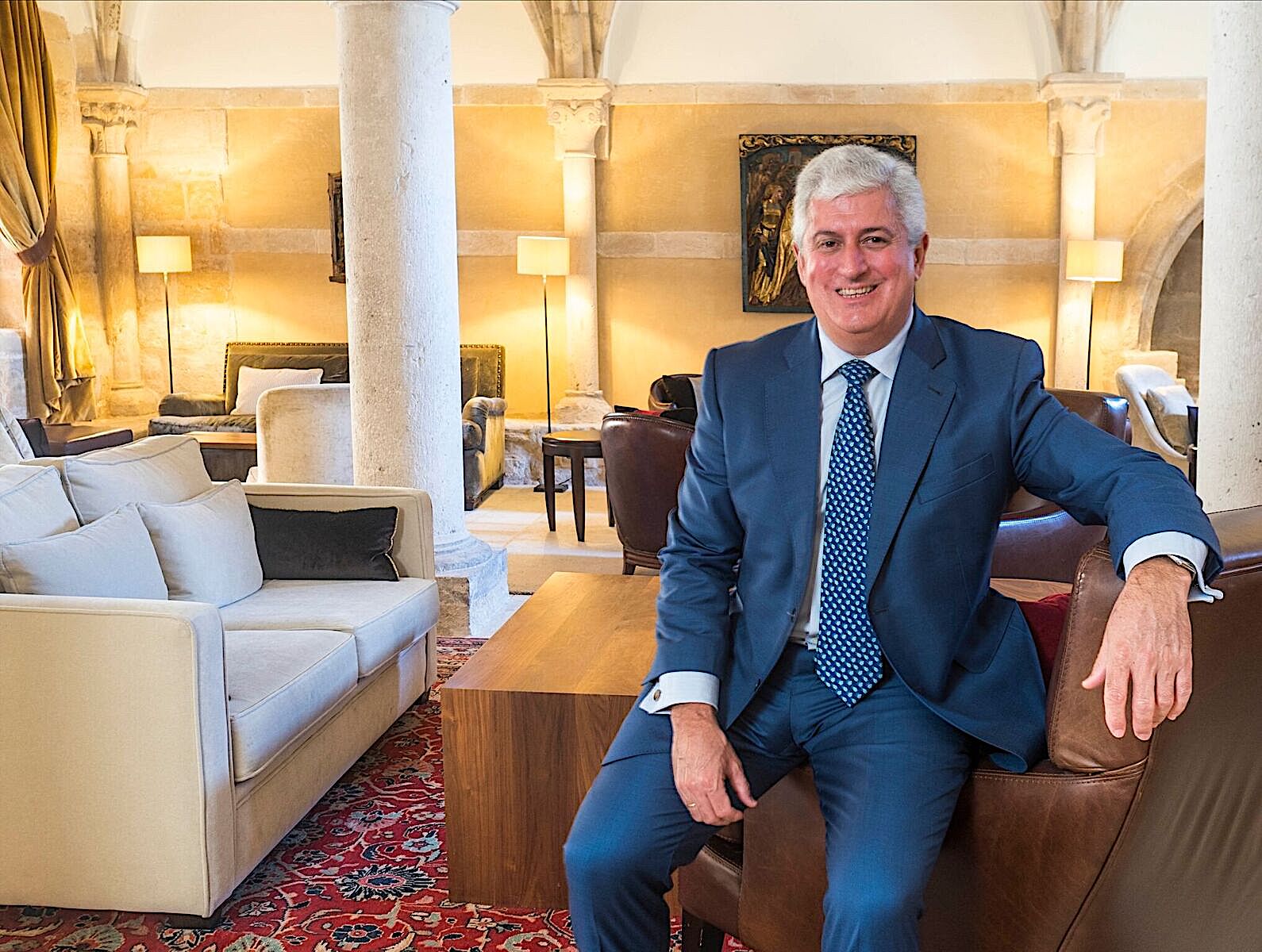 And that
was something of a problem for the
estate of Abadia Retuerta, which built its
winery in 1996, twenty miles from
the city of
Valladolid. The problem was that all
of its 1,750
acres—500 planted as vineyards—lie outside the
official Ribera del Duero
appellation and therefore cannot print that
appellation on its label.
And that
was something of a problem for the
estate of Abadia Retuerta, which built its
winery in 1996, twenty miles from
the city of
Valladolid. The problem was that all
of its 1,750
acres—500 planted as vineyards—lie outside the
official Ribera del Duero
appellation and therefore cannot print that
appellation on its label.
“It was a little bit
frustrating at the very beginning,in the 90’s
because we did not have an
appellation to facilitate our international
distribution," says General
Manager Enrique Valero (left). "Vega Sicilia is 5
miles away from us and belongs
to the Ribera del Duero appellation and we were
Vino de la Tierra. Now almost
30 years later we have developed our own Pago (terroir)
wines and we are very proud of the
personality they have and the international
recognition they have gained thanks
to a very consistent way of working that
respects the Duero soils and the
climate conditions in one of the best parts of
Spain to produce top wines. Time
has demonstrated we were right."
Over dinner in New
York, Valera explained that “Even though we’re
on
what is called ‘the Golden Mile,’ we have had to
distinguish ourselves wholly
on the quality of our wine, not our location.
We’ve only been planting since
1996 and can only call ourselves a Vino de la
Tierra; but in 2005 our Selección
Especial 2001 won the International Wine
Challenge in London as the world’s
best red wine.” That deserved a toast. 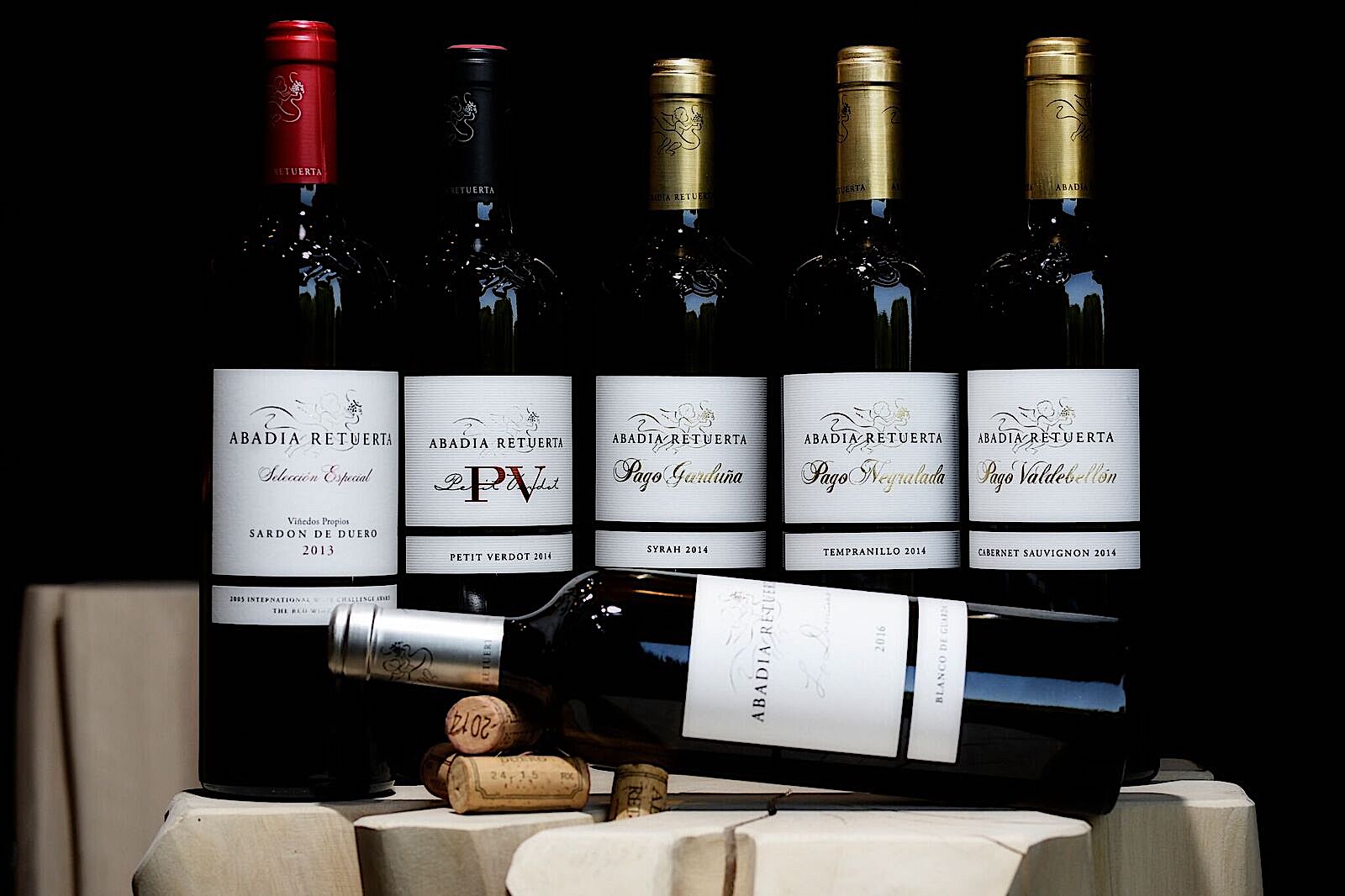
If not quite so soon, it might have been
expected that Abadia Ruerta would compete well
in the European market, for when
the Swiss multinational pharmaceutical giant
Novartis purchased the property,
it brought in consulting enologist Pascal
Delbeck, proprietor of the
illustrious Premier Grand Cru Bordeaux Château
Ausone, who was given the money
and technological carte blanche to create a
completely modern facility, which
uses a state-of-the-art gravity flow irrigation
system. The
vineyards are planted with
Tempranillo, Cabernet Sauvignon, Merlot, Syrah
and Petit Verdot, and the wines
are aged in combinations of stainless steel,
French and American oak.
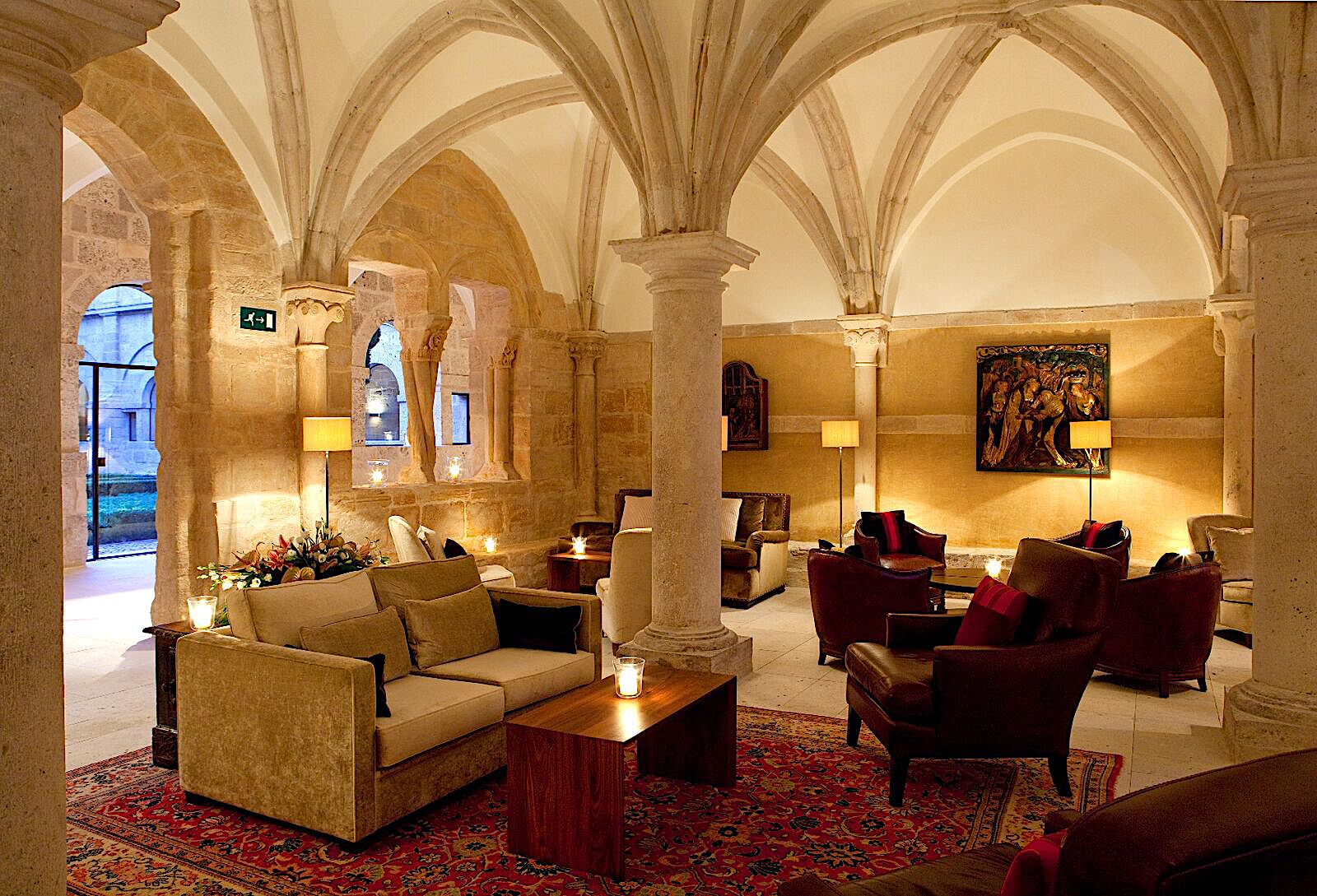 “The
good thing about being outside the Ribera
del Duero DO,” said Quintana, “is that we can
use drip irrigation if
needed.” He
went on to say that
climate change and global warming have affected
the way the grapes are grown
and harvested. “We’ve also thought about
starting to grow other grapes, which
we can do outside the DO. So there are several
advantages to our location.”
“The
good thing about being outside the Ribera
del Duero DO,” said Quintana, “is that we can
use drip irrigation if
needed.” He
went on to say that
climate change and global warming have affected
the way the grapes are grown
and harvested. “We’ve also thought about
starting to grow other grapes, which
we can do outside the DO. So there are several
advantages to our location.”
Indeed,
the location has allowed the estate to
build a deluxe hotel and spa called Le’Domaine,
contained within an abbey founded in 1146 by
Premonstratensian monks, who were originally
from France. Swiss-Italian
architect Marco Serra did a total renovation of
monk’s cells into intimate
bedrooms, with the hotel opening in 2012,
retaining much of the abbey’s
decorative features and sculpture.
The Sanctuario Spa covers 10,000 square
feet and offers “oeotherapy
treatments” recommended by a “spa sommelier.”
Over a dinner of Italian pastas, I tasted the
current Selección Especial from a 2014 vintage
(bottles dating back to the first vintage are
still available for sale) and found it a
remarkable Spanish
wine with Bordeaux levels of flavor, soft
tannins and, even so young, very pleasing
to drink and only likely to get better over the
next five years. At about $26
to $30 a bottle it is justly a contender against
the rest of the best Spain has
to offer right now.
Sorry to say, most of
Abadia Retuerta’s wines
are sold directly to restaurants, but a check of
winesearcher.com pulled up a
good number of wine stores around the U.S. that
carry the wine. One of these
days I’d like to drink the wine with dinner
after a oenotherapy treatment at
Le’Domaine, but for now it’s good to know I can
find the wine on American soil.
❖❖❖
 OK, THEN HOW ABOUT DEVIL’S FOOD
CAKE
OK, THEN HOW ABOUT DEVIL’S FOOD
CAKE
AND A PITCHER
OF BLOODY MARYS?
Toronto-based Sweet Jesus Ice Cream is facing boycotts from a Christian organization call An Citizengo over its name for being "blasphemous." “Choosing the name of our Lord for a brand of soft-serve ice cream is totally offensive and revolting,” says the petition’s creator. “Both in their promotional materials and menu selection, it is plain to see that [founders Andrew] Richmond and [Amin] Todai have every intention of mocking Christ and Christianity." A disclaimer on the company's website contends that the name “was created from the popular phrase that people use as an expression of enjoyment, surprise or disbelief,” and that Sweet Jesus does not intend to “offer commentary on anyone’s religion or belief systems. After a lot of thought, we have decided that we will not make a change.”
SHE FORGOT TO MENTION WHO'LL PAY
FOR THE DIABETES DRUGS LATER ON
Kellyanne
Conway, Counselor to the President and coordinator of
efforts to fight the opioid epidemic, told the
Generation Next forum in
Washington, D.C., that college students could
avoid addiction by indulging in junk food instead
of opioid drugs. “On our college campuses, your folks are
reading the labels, they won’t put any sugar in their
body, they
don’t
eat carbs anymore,” said Conway. “They’re very, very
fastidious about what
goes into their body. And then you buy a street drug for
$5 or $10 and it’s
laced with fentanyl, and that’s it. So I guess my short
advice is, as somebody
double your age, eat
the ice
cream, have the French fry, don’t buy the street drug.
Believe me, it all
works out.”
❖❖❖
Wine
Column Sponsored by Banfi Vintners
SANGIOVESE
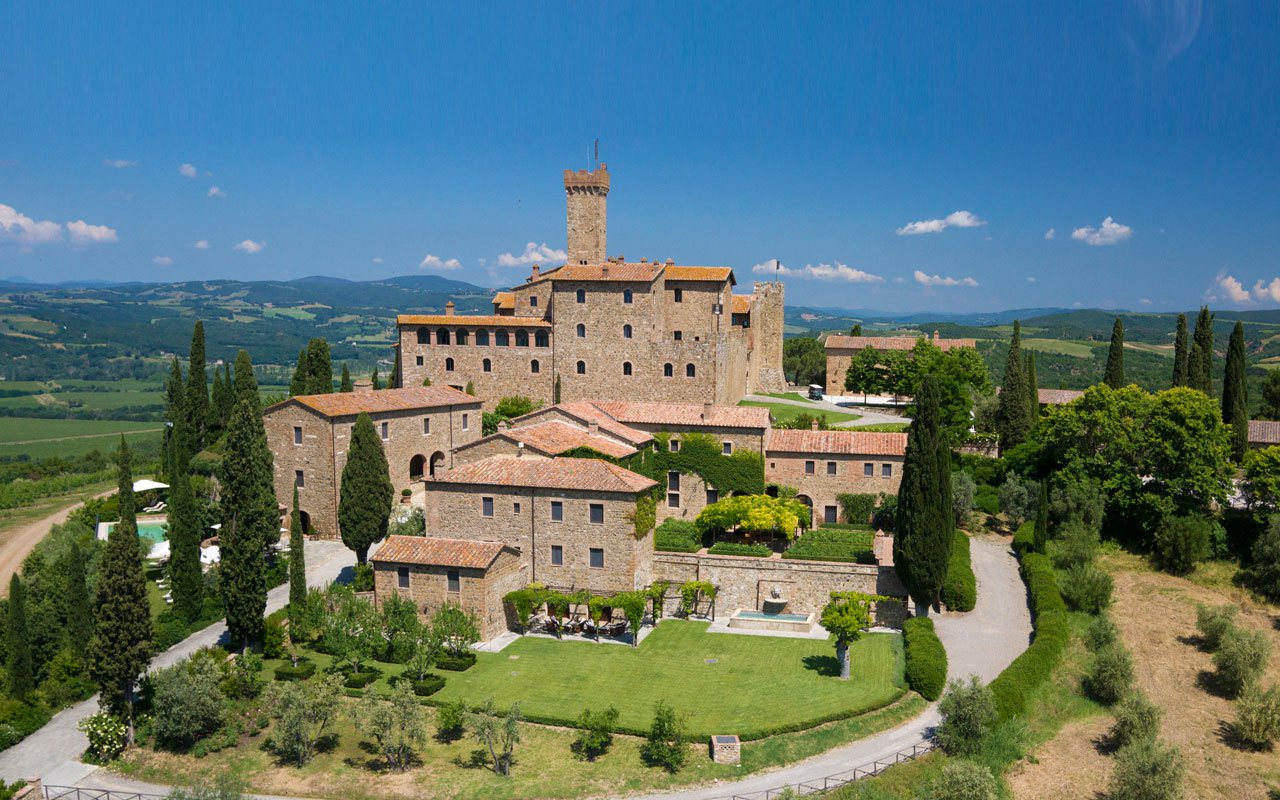 Wine is a joy year-round but
in cooler weather one
grape varietal has really taken center stage in
my daily activities – that most Italian of
grapes, Sangiovese, and its ultimate expression
– Brunello di Montalcino.
Wine is a joy year-round but
in cooler weather one
grape varietal has really taken center stage in
my daily activities – that most Italian of
grapes, Sangiovese, and its ultimate expression
– Brunello di Montalcino.
From mid-September through mid-October,
the Sangiovese grown for our various styles of red
wines are be harvested, culminating with the top
selection for Brunello di Montalcino.
Second, cooler weather here means
it is time to start enjoying more red wines and
especially Sangiovese based wines. That
includes Banfi’s cru of Brunello, Poggio alle Mura,
literally the cream of the crop of our Sangiovese
vineyards. Alongside our Poggio alle Mura Brunello di
Montalcino, this year we introduced two more wines
from the cru Poggio alle Mura – a Rosso di Montalcino
and a Riserva of Brunello. Rosso is sort of like the
younger brother of Brunello, also made from 100%
Sangiovese grapes but usually a selection from younger
vines and the wine is aged only two years compared to
the four required for Brunello. The
Riserva, on the other hand, is an even more selective
harvest of Sangiovese, and ages for an additional year
before release.
What is so special about this cru
Poggio alle Mura?
Well, it is the result our over 30 years of
ongoing research at my family’s vineyard estate,
Castello Banfi.
When we first began planting our vines there in
the late 1970s studies from the University of Bordeaux
indicated which strains of many varietals we should
plant, based on the soil type and microclimate of each
vineyard. But
when it came to the region’s native Sangiovese, there
was only local lore, no scientific research. So we took
it upon ourselves to figure out this vine, and set off
on three decades of incredibly detailed research.
We started
with 600 apparent variations on Sangiovese, because it
is so susceptible to variations in weather and soil,
and narrowed that down to 160 truly genetically
different clones.
We planted a vineyard with two rows of each
type, made wine from each of them, and charted the
differences – remember, you only get one chance a year
to make wine, so this took time.
It took about ten years to get some
concrete results, though we continue to experiment
today and always will – you never stop learning in
science and nature!
Once we determined which were the best,
complementary clones that could be planted together to
make the best Brunello, we chose to plant them in what
we determined to be the optimal vineyard sites. Coincidentally,
the best soils and climate conditions are in the
slopes surrounding the medieval fortress today known
as Castello Banfi, known since Etruscan times as
Poggio alle Mura – the walled hilltop. Hence the
name of our most special “cru” of Brunello,
representing a synthesis between tradition and
innovation.
Though the focus of this study was
our Brunello, all of our Sangiovese-based wines,
including the super Tuscans SummuS, Cum Laude, and
Centine, benefited from this work. And that’s
the third reason for celebrating Sangiovese this
month, for the range of wonderful reds that usher us
into autumn! One
wine in particular was inspired by our research – the
BelnerO, a Sangiovese dominant blend with what I like
to call a kiss of Cabernet and a whisper of Merlot. We grow the
grapes a little differently for BelnerO than for
Brunello, make the wine with less oak aging and
released it earlier from the winery, providing a
counterpoint to Brunello and a lovely terroir-driven
wine in its own right.
If you
know Italians, you know that by nature we are
multi-faceted, varying in mood, and always passionate. As a
nation, we span from the hot sunny beaches of Sicily
near the African coast to the rugged mountains and
Alpine ski slopes of Trentino-Alto Adige in the north. Sangiovese
is grown in almost all of Italy’s regions and reflects
the unique nature of each; it is most famous
(rightfully so) in Tuscany, yet even there it reflects
the nuances of each hilltop, valley and subzone. It has
something a little different to say in Brunello than
Chianti, Morellino than Vino Nobile di Montepulciano,
Rosso di Montalcino than Super Tuscan blends.
Here is a smattering of
Sangiovese-based wines that you may wish to get to
know better, reflecting a spectrum that appeals to
every occasion, every taste, and every budget. We can
assure you that the conversation will never become
boring. 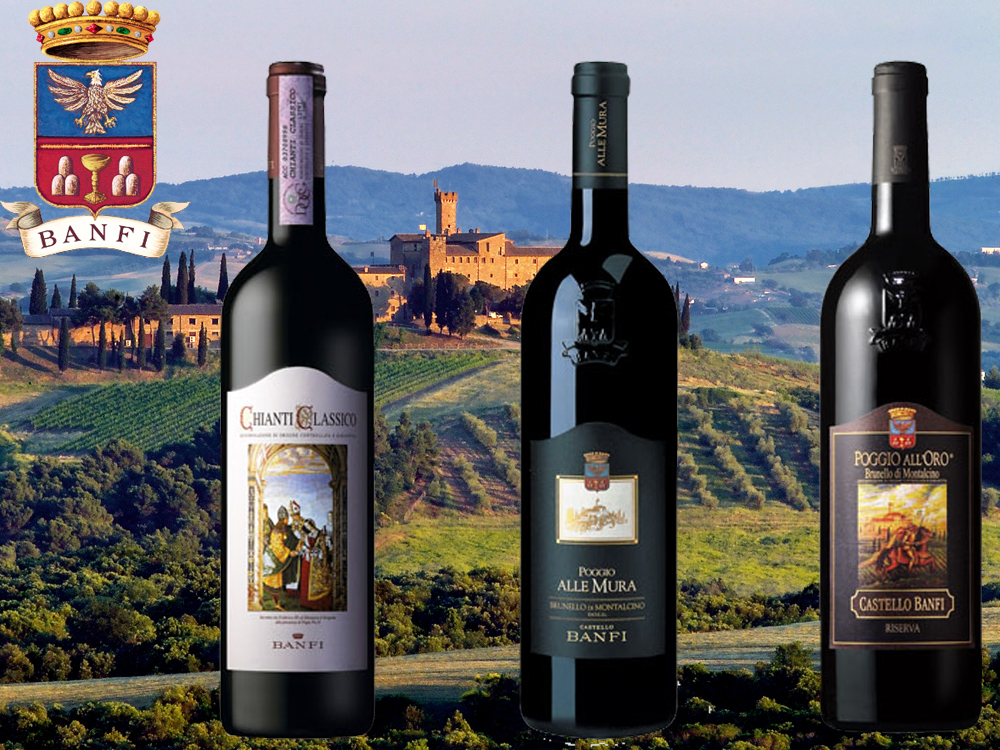
Recommendations for Celebrating
Sangiovese
BelnerO Proprietor’s Reserve Sangiovese
– A refined
cuvée of noble red grapes perfected by our pioneering
clonal research. This dark beauty, BelnerO, is
produced at our innovative winery, chosen 11
consecutive years as Italy’s Premier Vineyard Estate.
Fermented in our patented temperature controlled
French oak and aged approximately 2 additional years.
Unfiltered, and Nitrogen bottled to minimize sulfites.
Castello Banfi Brunello di Montalcino –
Rich, round, velvety and intensely
aromatic, with flavor hints of licorice, cherry, and
spices. Brunello di Montalcino possesses an intense
ruby-red color, and a depth, complexity and opulence
that is softened by an elegant, lingering aftertaste.
Unfiltered after 1998 vintage.
Castello Banfi Rosso di Montalcino – Brunello's "younger brother," produced
from select Sangiovese grapes and aged in barrique for
10 to 12 months. Deep ruby-red, elegant, vibrant,
well-balanced and stylish with a dry velvety
finish.
Poggio all’Oro Brunello di Montalcino
Riserva – A single vineyard selection of our most
historically outstanding Sangiovese, aged five years
before release, the additional year more than that
required of Brunello including 6 months in barrel and
6 months more in bottle to grant its “Riserva”
designation. Incredible
elegance and harmony. Intense with lots of fruit and
subtle wood influence. Round, complete, well balanced
with hints of chocolate and berries. Unfiltered after
1998.
Poggio alle Mura – The first tangible result of years of
intensive clonal research on Montalcino’s native
Sangiovese grape.
Estate bottled from the splendidly sun drenched
vineyards surrounding the medieval Castello from which
it takes its name.
The Brunello
di Montalcino is seductive, silky and smoky. Deep ruby
in color with an expressive bouquet of violets, fruits
and berries as well as cigar box, cedar and exotic
spices. The Rosso
di Montalcino is also intense ruby red. The bouquet
is fresh and fruity with typical varietal notes of
cherry and blackberry, enriched by more complex hints
of licorice, tobacco and hazelnut. It is full
bodied, yet with a soft structure, and a surprisingly
long finish. The Poggio alle Mura Brunello di Montalcino
Riserva is deep ruby red with garnet
reflections and a rich, ample bouquet that hints of
prune jam, coffee, cacao and a light balsamic note. It is full
and powerful, with ripe and gentle tannins that make
it velvety and harmonious; this wine is supported by a
pleasing minerality that to me speaks soundly of that
special hillside in southern Montalcino.
SummuS – A wine of towering elegance, SummuS is an
extraordinary blend of Sangiovese which contributes
body; Cabernet Sauvignon for fruit and structure; and
Syrah for elegance, character and a fruity bouquet. An elegant,
complex and harmonious red wine.
Cum Laude – A complex and elegant red which graduated
“With Honors,” characterized by aromas of juicy
berries and fresh spices.
Centine – A Cuvee that is more than half
Sangiovese, the balanced consisting of equal parts of
Cabernet Sauvignon and Merlot. Vinified in
a firm, round style that easily accompanies a wide
range of dishes, this is a smooth and fragrantly
satisfying wine with international character, and a
perennial favorite at my own dinner table.
Banfi Chianti Superiore – The “Superiore” designation signifies
stricter government regulations regarding production
and aging requirements, as compared to regular
Chianti. An
intense ruby red wine with fruit forward aromas and
floral notes. This
is a round wine with well-balanced acidity and fruit.
Banfi Chianti Classico – An enduring classic: alluring
bouquet of black fruit and violets; rich flavors of
cherry and leather; supple tannins and good acidity
for dining.
Banfi Chianti Classico Riserva – Produced from select grapes grown in the
"Classico" region of Chianti, this dry, fruity and
well-balanced red has a full bouquet reminiscent of
violets.
Fonte alla Selva Chianti Classico – This is our newest entry into the Chianti
arena, coming from a 99 acre estate in Castellina, the
heart of the Chianti Classico region. The wine is
a captivating mauve red that smells of cherry, plum
and blackberry with hints of spice. It is
round, full and balanced with very good
acidity.
Col di Sasso – Sangiovese and Cabernet Sauvignon. Luscious,
complex and soft with persistent notes of fruit and
great Italian style structure.
Any of John Mariani's books below may be ordered from amazon.com.
 The Hound in Heaven
(21st Century Lion Books) is a novella, and
for anyone who loves dogs, Christmas, romance,
inspiration, even the supernatural, I hope you'll find
this to be a treasured favorite. The story
concerns how, after a New England teacher, his wife and
their two daughters adopt a stray puppy found in their
barn in northern Maine, their lives seem full of promise.
But when tragedy strikes, their wonderful dog Lazarus and
the spirit of Christmas are the only things that may bring
his master back from the edge of despair.
The Hound in Heaven
(21st Century Lion Books) is a novella, and
for anyone who loves dogs, Christmas, romance,
inspiration, even the supernatural, I hope you'll find
this to be a treasured favorite. The story
concerns how, after a New England teacher, his wife and
their two daughters adopt a stray puppy found in their
barn in northern Maine, their lives seem full of promise.
But when tragedy strikes, their wonderful dog Lazarus and
the spirit of Christmas are the only things that may bring
his master back from the edge of despair. WATCH THE VIDEO!
“What a huge surprise turn this story took! I was completely stunned! I truly enjoyed this book and its message.” – Actress Ali MacGraw
“He had me at Page One. The amount of heart, human insight, soul searching, and deft literary strength that John Mariani pours into this airtight novella is vertigo-inducing. Perhaps ‘wow’ would be the best comment.” – James Dalessandro, author of Bohemian Heart and 1906.
“John Mariani’s Hound in Heaven starts with a well-painted portrayal of an American family, along with the requisite dog. A surprise event flips the action of the novel and captures us for a voyage leading to a hopeful and heart-warming message. A page turning, one sitting read, it’s the perfect antidote for the winter and promotion of holiday celebration.” – Ann Pearlman, author of The Christmas Cookie Club and A Gift for my Sister.
“John Mariani’s concise, achingly beautiful novella pulls a literary rabbit out of a hat – a mash-up of the cosmic and the intimate, the tragic and the heart-warming – a Christmas tale for all ages, and all faiths. Read it to your children, read it to yourself… but read it. Early and often. Highly recommended.” – Jay Bonansinga, New York Times bestselling author of Pinkerton’s War, The Sinking of The Eastland, and The Walking Dead: The Road To Woodbury.
“Amazing things happen when you open your heart to an animal. The Hound in Heaven delivers a powerful story of healing that is forged in the spiritual relationship between a man and his best friend. The book brings a message of hope that can enrich our images of family, love, and loss.” – Dr. Barbara Royal, author of The Royal Treatment.
 |
The Encyclopedia of American Food and Drink by John F. Mariani (Bloomsbury USA, $35) Modesty forbids me to praise my own new book, but let me proudly say that it is an extensive revision of the 4th edition that appeared more than a decade ago, before locavores, molecular cuisine, modernist cuisine, the Food Network and so much more, now included. Word origins have been completely updated, as have per capita consumption and production stats. Most important, for the first time since publication in the 1980s, the book includes more than 100 biographies of Americans who have changed the way we cook, eat and drink -- from Fannie Farmer and Julia Child to Robert Mondavi and Thomas Keller. "This book is amazing! It has entries for everything from `abalone' to `zwieback,' plus more than 500 recipes for classic American dishes and drinks."--Devra First, The Boston Globe. "Much needed in any kitchen library."--Bon Appetit. |
"Eating Italian will never be the same after reading John Mariani's entertaining and savory gastronomical history of the cuisine of Italy and how it won over appetites worldwide. . . . This book is such a tasteful narrative that it will literally make you hungry for Italian food and arouse your appetite for gastronomical history."--Don Oldenburg, USA Today. "Italian
restaurants--some good, some glitzy--far
outnumber their French rivals. Many of
these establishments are zestfully described
in How Italian Food Conquered the World, an
entertaining and fact-filled chronicle by
food-and-wine correspondent John F.
Mariani."--Aram Bakshian Jr., Wall Street
Journal.
"Equal parts
history, sociology, gastronomy, and just
plain fun, How Italian Food Conquered the
World tells the captivating and delicious
story of the (let's face it) everybody's
favorite cuisine with clarity, verve and
more than one surprise."--Colman Andrews,
editorial director of The Daily
Meal.com. "A fantastic and fascinating
read, covering everything from the influence
of Venice's spice trade to the impact of
Italian immigrants in America and the
evolution of alta cucina. This book will
serve as a terrific resource to anyone
interested in the real story of Italian
food."--Mary Ann Esposito, host of PBS-TV's
Ciao
Italia. "John Mariani has written the
definitive history of how Italians won their
way into our hearts, minds, and
stomachs. It's a story of pleasure over
pomp and taste over technique."--Danny Meyer,
owner of NYC restaurants Union Square
Cafe, The Modern, and Maialino.
|
 |
 |
 |
 |
 |
 |
 |
 |
 Everett Potter's Travel Report:
Everett Potter's Travel Report: 
 Eating Las Vegas
JOHN CURTAS has been covering the Las Vegas
food and restaurant scene since 1995. He is
the co-author of EATING LAS VEGAS – The 50
Essential Restaurants (as well as
the author of the Eating Las Vegas web site: www.eatinglasvegas.
He can also be seen every Friday morning as
the “resident foodie” for Wake Up With the
Wagners on KSNV TV (NBC) Channel 3 in
Las Vegas.
Eating Las Vegas
JOHN CURTAS has been covering the Las Vegas
food and restaurant scene since 1995. He is
the co-author of EATING LAS VEGAS – The 50
Essential Restaurants (as well as
the author of the Eating Las Vegas web site: www.eatinglasvegas.
He can also be seen every Friday morning as
the “resident foodie” for Wake Up With the
Wagners on KSNV TV (NBC) Channel 3 in
Las Vegas.

MARIANI'S VIRTUAL GOURMET
NEWSLETTER is published weekly. Editor/Publisher: John
Mariani.
Editor: Walter Bagley. Contributing Writers: Christopher Mariani,
Robert Mariani, Misha Mariani, John A. Curtas, Geoff Kalish, Mort
Hochstein, and
Brian Freedman. Contributing Photographer: Galina
Dargery. Technical Advisor: Gerry McLoughlin.
If you wish to subscribe to this
newsletter, please click here: http://www.johnmariani.com/subscribe/index.html
© copyright John Mariani 2017

